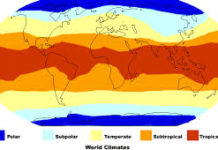Monitoring Desk
May 2020 was the warmest May on record, according to the Copernicus Climate Change Service (C3S), implemented by the European Centre for Medium-Range Weather Forecasts on behalf of the European Commission. It was 0.63°C warmer than the average May from 1981-2010.
The most above-average temperatures were recorded over parts of Siberia – where they were up to 10°C above average. They were also much above average over western Alaska, along the Andes bordering Chile and Argentina, and over regions in West and East Antarctica. It was also much warmer than average over western North America, the far north and south of South America, north-western, central and south-western Africa, and south-eastern Asia.
Regions of below-average temperature include most of central and eastern Canada, the eastern USA, southern Brazil, parts of southern Asia, and Australia, according to the C3S data.
Boreal spring was marked by highly anomalous temperatures over Siberia, which reached close to 10°C above the 1981-2010 average over the lower reaches of the Ob and Yenisei rivers in the north-west of the region, according to the report.
Carbon dioxide concentrations measured at Mauna Loa observing station in Hawaii reached a seasonal peak of 417.1 parts per million for 2020 in May, the highest monthly reading ever recorded, according to scientists from NOAA and Scripps Institution of Oceanography at the University of California San Diego.
Mauna Loa is the longest established observing station and is regarded as a benchmark in WMO’s Global Atmosphere Watch programme, which consists of observing stations in more than 50 countries, is monitoring global trends.
Concentrations of CO2 are subject to seasonal and regional fluctuations. The seasonal maximum usually occurs early in the Northern hemisphere spring before vegetation growth absorbs CO2 levels are lower for the rest of the year. The annual global average will therefore not be as high as the monthly Mauna Loa figure.
This year’s peak value was 2.4 parts per million (ppm) higher than the 2019 peak of 414.7 ppm recorded in May 2019. Monthly CO2 values at Mauna Loa first breached the 400 ppm threshold in 2014, and are now at levels not experienced by the atmosphere in several million years.















